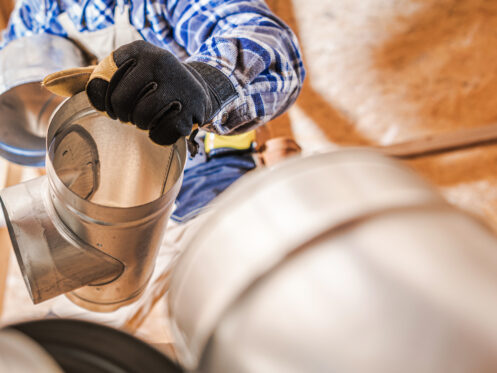Ductwork design can help or hinder your HVAC unit’s efficiency. While most homeowners pay little attention to their ductwork, the network of ducts and vents work in conjunction with your HVAC unit to distribute cold or hot air throughout your home. Proper ductwork design is vital for balanced airflow and uniform temperature of the HVAC system.
Understanding HVAC Ductwork
Proper duct design factors in sizing, the building’s layout, vent location, and HVAC capacity. Optimized duct sizing prevents energy waste and ensures adequate airflow. A well-planned layout promotes even temperature distribution. By considering all factors during the design process, your ductwork will ensure both comfort and energy efficiency.
Several main types of HVAC ducts are used in homes and buildings, including:
Flexible Ductwork
Made of a metal wire coil covered with flexible plastic and thermal insulation like glass wool, polyethylene, or metalized PET, flexible ducts are typically used in spaces with limited room.
Rigid Ductwork
These rigid, reliable, safe, and durable ducts come in various shapes, sizes, and materials to better meet your needs. Subtypes of rigid ductwork include:
Sheet Metal Ducts
These ducts are made of galvanized steel or aluminum, which is preferred for being lightweight and easy to install. Metal is a non-porous material, which helps prevent mold and other growths.
Fiberglass-lined Ducts
Similar to sheet metal but with internal or external fiberglass lining, fiberglass-lined ducts dampen AC sound and are mostly preferred in commercial buildings and offices. They are not recommended for residential use because they can deteriorate, release fiberglass particles, allow mold/bacteria to grow, and are difficult to clean.
Fiberboard Ducts
These comprise compressed resin-bonded fiberglass that is laminated with a foil sheet for moisture protection. They are insulated, which makes them preferred for heating/cooling. Overall, fiberboard ducts are not recommended for ventilation due to the potential for mold and bacteria growth.
Regular professional duct cleaning is important for maintaining indoor air quality. Consult Main Street Heating & Cooling for recommended cleaning frequency.
9 Benefits of Properly Designed Ducts
1. Enhances Indoor Air Quality
Pollutants such as dust and allergens can accumulate inside your ductwork in no time with unsealed ducts. The contaminants can then find their way inside your home and worsen symptoms for individuals with allergies and respiratory problems. An adequately designed ductwork can support proper filtering and purifying as the air is distributed by preventing the buildup of these pollutants. Proper ventilation ensures good air quality. When you involve HVAC professionals in your ductwork installation, they can create an airtight system that does not allow contaminants to enter your system.
2. Reduces Noise
Another advantage of proper air duct design is the reduced level of noise from your HVAC equipment. Poorly designed duct units produce rattling noises, which can be disturbing. This happens as air passes through a narrow or blocked passage. The noises disrupt peace and also serve as an indication of inefficiencies or restrictions within the unit. During winter, ducts expand as the heated air travels through them and contract when the system cools. It’s this expansion and contraction that causes the creaking noises. Making sure you receive the correct ductwork design installation will protect your quiet environment.
3. Increases Comfort
Poorly designed ductwork systems can lead to uneven heating or cooling. You might notice some rooms are overly warm while others are drafty, and temperatures are inconsistent from one space to the next. You might find yourself constantly adjusting your thermostat and feeling less satisfied with the results. With correctly sealed and installed ducts, your home will remain more consistently comfortable in all seasons. The ducts will move conditioned air freely and easily to bring each room to the desired temperature. You’ll feel more comfortable, and your HVAC system will be less strained.
4. Extends Lifespan for Your HVAC System
Correctly installed HVAC ductwork increases the longevity of your system. When ducts are inefficient or poorly installed, your system can be unnecessarily strained. It will have to work harder to make up for the loss of conditioned air and maintain a consistent temperature. Over time, this excess strain can add to increased wear and tear, reduce the lifespan of your system, and increase the risk of breakdowns. Properly designed and installed ductwork minimizes the chances of damage to your HVAC unit. The heating and cooling components become less vulnerable to wear and tear, and their lifespan is maximized.
5. Optimizes Performance
With proper ductwork design installation, the ductwork is secure and sufficiently insulated to stop air leakage. It also prevents the degrading of the quality of duct joints for maximum system performance, which saves on energy and expenses.
6. Helps the Environment
Proper ductwork design ensures the ducts are insulated to minimize heat loss through conduction. This enables the HVAC system to maintain a comfortable temperature and reduces the energy used. With less energy consumed and wasted, the fuel required to generate power also reduces and ultimately reduces greenhouse gases. This leads to reduced air and water pollution for a healthier living environment.
7. Energy Efficiency
Ductwork design is helpful when it comes to energy efficiency. Well-designed ductworks minimize air leaks, unlike poorly designed ones, which develop leaks, buildup, and more. Poorly designed ducts decrease an HVAC’s efficiency, and the unit will consume more energy to perform properly.
8. Prevents the Growth of Mold and Fungus
Poorly designed ductwork allows condensation and moisture problems to occur, creating a breeding ground for fungi and mold. This results in an unhealthy living situation for anyone in the affected building. Properly selecting and designing ductwork and insulation will minimize the risk of condensation within the ducts and help reduce the risk of microbial growth.
9. Saves Money
Saving money is among the best things about having a properly designed ductwork. Your unit will be more efficient as it does not have to work as hard to circulate air into different parts of your home. Air coming from your registers remains cool thanks to insulation, and it has a shorter distance to travel through the ducts. Your HVAC system will experience less wear and tear, which translates to fewer repair bills, and the lowered energy costs mean more money in your pocket.
Call the Experts and Book an Appointment Today for All Your Ductwork Needs
Proper duct design is a key component of a functional HVAC system. It impacts your home’s indoor air quality, noise levels, and overall comfort. Neglecting the design of your ductwork can bring potential health concerns, high utility bills, and a lowered lifespan for your HVAC unit. HVAC professionals prioritize proper duct design to ensure the system’s optimal performance and complete satisfaction.
At Main Street Heating & Cooling, we provide equipment that brings better breathability to your home. With budget-friendly and careful tune-ups, you can trust us to install appropriately designed ductwork in Sandy, UT and the Salt Lake Valley. We also offer plumbing, heating, and cooling services, which you can count on us to deliver on quality. Contact us today for unmatched HVAC services.


